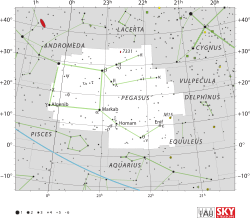Zeta Pegasi

| |
| Observation data Epoch J2000.0 Equinox J2000.0 | |
|---|---|
| Constellation | Pegasus |
| Right ascension | 22h 41m 27.72072s[1] |
| Declination | +10° 49′ 52.9079″[1] |
| Apparent magnitude (V) | +3.414[2] |
| Characteristics | |
| Spectral type | B8 V[3] |
| U−B color index | –0.181[2] |
| B−V color index | –0.088[2] |
| Variable type | SPB[4] |
| Astrometry | |
| Radial velocity (Rv) | +7.0[5] km/s |
| Proper motion (μ) | RA: +77.22[1] mas/yr Dec.: –11.38[1] mas/yr |
| Parallax (π) | 15.96 ± 0.19[1] mas |
| Distance | 204 ± 2 ly (62.7 ± 0.7 pc) |
| Details | |
| Radius | 4.03 ± 0.22[6] R☉ |
| Surface gravity (log g) | 3.67 ± 0.05[6] cgs |
| Temperature | 11,190 ± 55[6] K |
| Rotational velocity (v sin i) | 140[7]–210[8] km/s |
| Age | 120[8] Myr |
| Other designations | |
Zeta Pegasi (ζ Pegasi, abbreviated Zeta Peg, ζ Peg), also named Homam,[10] is a single[11] star in the northern constellation of Pegasus. With an apparent visual magnitude of +3.4,[2] this star is bright enough to be seen with the naked eye and is one of the brighter members of Pegasus. Parallax measurements place it at a distance of around 204 light-years (63 parsecs) from the Sun.[1]
Nomenclature
ζ Pegasi (Latinised to Zeta Pegasi) is the star's Bayer designation.
It bore the traditional name Homam, meaning "Man of High Spirit" or "Lucky Star of High Minded". In 2016, the International Astronomical Union organized a Working Group on Star Names (WGSN)[12] to catalogue and standardize proper names for stars. The WGSN approved the name Homam for this star on 21 August 2016 and it is now so entered in the IAU Catalog of Star Names.[10]
Properties
This star has a stellar classification of B8 V,[3] which identifies it as a large B-type main sequence star that is generating energy through the nuclear fusion of hydrogen at its core. The radius of this star is about four times that of the Sun.[6] It is a slowly pulsating B star that varies slightly in luminosity with a period of 22.952 ± 0.804 hours, completing 1.04566 cycles per day.[4] Zeta Pegasi is about 120[8] million years old and is rotating rapidly with a projected rotational velocity in the range of 140[7]–210[8] km s−1. The effective temperature of its outer envelope is around 11,190 K,[6] giving it the characteristic blue-white glow of a B-type star.[13]
Zeta Pegasi has been examined for infrared excess that may indicate the presence of circumstellar matter, but none was found.[14] This star does have two optical companions. The first is a magnitude 11.6 star at an angular separation of 68 arcseconds along a position angle of 139°, as of 1997.[4] The second is an 11th magnitude star at a separation of 177 arcseconds with a position angle of 5°.[5] Zeta Pegasi is not known to be a member of a stellar association.[14]
References
- 1 2 3 4 5 6 van Leeuwen, F. (November 2007), "Validation of the new Hipparcos reduction", Astronomy and Astrophysics, 474 (2): 653–664, arXiv:0708.1752
 , Bibcode:2007A&A...474..653V, doi:10.1051/0004-6361:20078357
, Bibcode:2007A&A...474..653V, doi:10.1051/0004-6361:20078357 - 1 2 3 4 Gutierrez-Moreno, Adelina; et al. (1966), A System of photometric standards, 1, Publicaciones Universidad de Chile, Department de Astronomy, pp. 1–17, Bibcode:1966PDAUC...1....1G
- 1 2 Palmer, D. R.; et al. (1968), "The radial velocities spectral types and projected rotational velocities of 633 bright northern A stars", Royal Observatory Bulletin, 135: 385, Bibcode:1968RGOB..135..385P
- 1 2 3 Goebel, John H. (May 2007), "Gravity Probe B Photometry and Observations of ζ Pegasi: An SPB Variable Star", The Publications of the Astronomical Society of the Pacific, 119 (855): 483–493, Bibcode:2007PASP..119..483G, doi:10.1086/518618
- 1 2 Wielen, R.; et al. (1999), Sixth Catalogue of Fundamental Stars (FK6). Part I. Basic fundamental stars with direct solutions (35), Astronomisches Rechen-Institut Heidelberg, Bibcode:1999VeARI..35....1W
- 1 2 3 4 5 Fitzpatrick, E. L.; Massa, D. (March 2005), "Determining the Physical Properties of the B Stars. II. Calibration of Synthetic Photometry", The Astronomical Journal, 129 (3): 1642–1662, arXiv:astro-ph/0412542
 , Bibcode:2005AJ....129.1642F, doi:10.1086/427855
, Bibcode:2005AJ....129.1642F, doi:10.1086/427855 - 1 2 Abt, Helmut A.; Levato, Hugo; Grosso, Monica (July 2002), "Rotational Velocities of B Stars", The Astrophysical Journal, 573 (1): 359–365, Bibcode:2002ApJ...573..359A, doi:10.1086/340590
- 1 2 3 4 Rieke, G. H.; et al. (February 2005), "Decay of Planetary Debris Disks", The Astrophysical Journal, 620 (2): 1010–1026, Bibcode:2005ApJ...620.1010R, doi:10.1086/426937
- ↑ "zet Peg -- Star in double system", SIMBAD Astronomical Object Database, Centre de Données astronomiques de Strasbourg, retrieved 2012-03-01
- 1 2 "IAU Catalog of Star Names". Retrieved 28 July 2016.
- ↑ Roberts, Lewis C., Jr.; Turner, Nils H.; ten Brummelaar, Theo A. (February 2007), "Adaptive Optics Photometry and Astrometry of Binary Stars. II. A Multiplicity Survey of B Stars", The Astronomical Journal, 133 (2): 545–552, Bibcode:2007AJ....133..545R, doi:10.1086/510335
- ↑ IAU Working Group on Star Names (WGSN), International Astronomical Union, retrieved 22 May 2016.
- ↑ "The Colour of Stars", Australia Telescope, Outreach and Education, Commonwealth Scientific and Industrial Research Organisation, December 21, 2004, retrieved 2012-01-16
- 1 2 Su, K. Y. L.; et al. (December 2006). "Debris Disk Evolution around A Stars". The Astrophysical Journal. 653 (1): 675–689. arXiv:astro-ph/0608563
 . Bibcode:2006ApJ...653..675S. doi:10.1086/508649.
. Bibcode:2006ApJ...653..675S. doi:10.1086/508649.